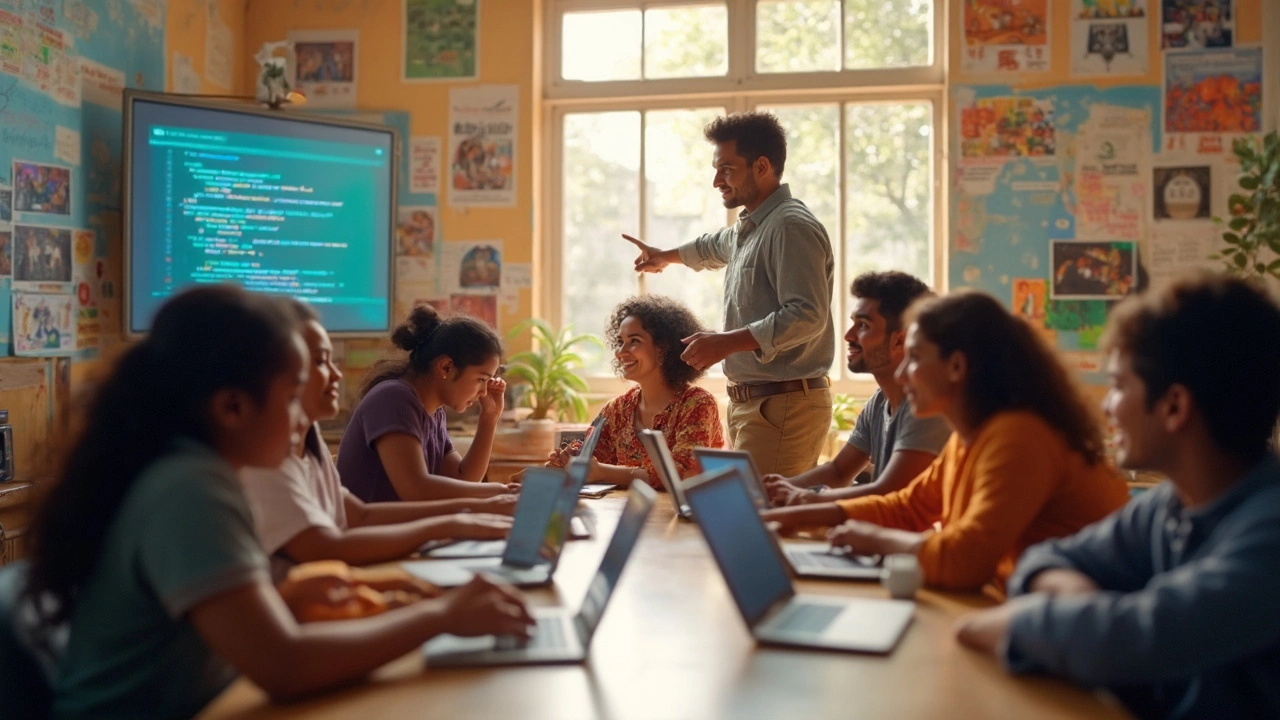
Choosing a coding class can feel like picking a new gym—you want results, but the options are overwhelming. The truth? The 'best' coding class really depends on what you want to do with it. If you’re dreaming about tech jobs, building your own app, or just trying to finally get what all the hype is about, there’s no one-size-fits-all answer. A class that's life-changing for one person might bore someone else out of their mind.
Popular names like Codecademy, freeCodeCamp, and Coursera are everywhere, and for a good reason: they start with the basics and don’t assume you know anything. You don’t need an engineering degree—just curiosity, and maybe a cup of coffee. These courses let you try stuff out for free before asking you to pay, which is perfect if you're not sure how deep you want to dive yet.
But here’s a tip you won’t hear everywhere: don’t just chase the fanciest name or the biggest price tag. Some of the best learning happens in smaller, community-driven classes or even local coding meetups. You get answers faster and real practice—no more endless theory without actually coding something.
- Where Most People Start: Beginner Coding Classes
- Live Bootcamps vs. Self-Paced Learning
- Picking the Right Class for Your Goals
- Tips to Make the Most of Any Coding Class
Where Most People Start: Beginner Coding Classes
Most folks dipping their toes into coding don’t start with some advanced course—no one’s dropping right into machine learning or backend systems their first week. The starting line is usually an online class built for beginners. Big products like coding classes from Codecademy, freeCodeCamp, or Udemy attract thousands every month for a reason: they’re clear, break big topics into bite-sized lessons, and let you get your hands dirty with real code right away. The most popular languages at the beginner level are HTML, CSS, JavaScript, and Python, because you can actually see results quickly or build small projects after a few lessons.
A lot of these courses use interactive sandboxes—meaning you don’t even need to install anything. You just log in, follow along, write your code, and hit run to see what happens. That’s huge for anyone who feels a bit tech-shy. According to a 2024 Course Report survey, 78% of adults who took their first online programming class said the simplicity of “learning by doing” helped keep them motivated.
Many beginner-level coding classes break things down into short videos and quizzes. Some offer community chat or forums, so you can ask questions and actually get help from either teachers or other students.
- Codecademy: Known for its hands-on, interactive approach and step-by-step guidance. Great for total newbies.
- freeCodeCamp: 100% free, project-based, and covers a wide toolbox of skills—web development, JavaScript, data visualization, and more.
- Udemy: A huge menu of beginner courses, often on sale, so you can find affordable options covering Python, Java, or web basics.
- Khan Academy: Especially good for younger students or visual learners, thanks to fun videos and interactive challenges.
Don’t get caught up trying to pick the “perfect” course when starting out. The best beginner class is the one you’ll actually stick with—so try a free lesson or two before committing. If you can do that consistently for a week, you’re already on a solid path.
Live Bootcamps vs. Self-Paced Learning
Here’s where a lot of people get stuck—do you sign up for a live bootcamp, or do you go at your own pace online? Both paths will teach you to code, but how you learn can make a huge difference in sticking with it.
Live bootcamps are like coding on steroids. You join in with a group, and for a few weeks or months, it’s full steam ahead—daily classes, projects, feedback, even mock interviews. Schools like General Assembly, Flatiron School, and Le Wagon are well-known for pumping out job-ready programmers fast. These programs are intense. You're expected to commit 30 to 60 hours a week, like a full-time job. The upside: you get tons of support and motivation from classmates and mentors. In fact, many bootcamp grads land their first tech jobs within six months of finishing.
But what if that ‘all-in’ style isn’t your thing? Self-paced courses let you fit coding around your life. Platforms like Udemy, freeCodeCamp, and Codecademy offer courses in every language and framework you could want. You could be squeezing in a lesson during your lunch break or grinding through projects on the weekend. It’s flexible, usually cheaper, and nobody’s breathing down your neck. The challenge? With no strict deadlines, it takes more discipline to keep going. That’s where a lot of people drift off and never finish.
Check this quick side-by-side:
| Live Bootcamps | Self-Paced Classes | |
|---|---|---|
| Time Commitment | Full-time, set schedule | Flexible, go at your own pace |
| Cost | $8,000 - $16,000 | Free - $300 (usually per course/module) |
| Support | Daily with mentors/classmates | Online forums or limited help |
| Job Support | Resume reviews, interviews, networking | Rarely included |
So what’s the real bottom line? If you want structure, accountability, and a push toward a new job, live bootcamps are hard to beat. If you’ve got a busy schedule or want to learn at your own speed, self-paced options win. Either way, focus on coding classes that fit your style—otherwise, you’ll just lose steam along the way.

Picking the Right Class for Your Goals
If you want to get the most out of coding classes, you’ve got to know what you’re actually aiming for. Are you switching careers, leveling up as a developer, or just playing around before dinner? Each path makes a big difference in which class will actually help you.
If you’re aiming for a tech job—say, junior web developer or data analyst—you’ll want classes with serious job placement stats. Bootcamps like General Assembly and Flatiron School have a solid rep for turning beginners into job-ready coders in 3-6 months. The price isn't cheap, but in some cases, they offer income share agreements, which means you pay after landing a job. That’s a big deal if you’re short on cash but long on ambition.
For folks who want to build a side hustle—maybe launch a small app or get freelance gigs—check out project-based classes. Udacity’s Nanodegree programs are all about real-world projects, plus you can learn at your own pace. That's handy if you’re juggling work or family and can't sit in a class at a set time every week.
- If you just want to play around or get the basics down, stick with free stuff at first. Platforms like freeCodeCamp or SoloLearn start with easy lessons and lots of small wins. No one judges you if you don't finish.
- If you learn best with a group, look for local classes or even online courses that come with private communities or live office hours. That bit of pressure and camaraderie helps tons of people make it to the finish line.
- Career switchers: Aim for courses that include mock interviews, resume reviews, and hands-on projects. Coding is half skill, half storytelling about those skills. The best bootcamps and online schools get that and build it in from day one.
Here’s a snapshot comparing a few popular options, just to give you a sense of what’s out there:
| Class | Best For | Timeline | Cost |
|---|---|---|---|
| General Assembly | Full-time job seekers | 3-6 months | $15,950 (2024) |
| Udacity Nanodegree | Self-paced, project lovers | 2-6 months | $399/month |
| freeCodeCamp | Budget learners, DIY folks | Flexible | Free |
| Coursera | College-style depth | Flexible | $39-$79/month |
Think about your routine, your bank account, and what you want out of all this. The best class isn’t always the fanciest. It’s the one you’ll stick with long enough to actually learn something.
Tips to Make the Most of Any Coding Class
Signing up for coding classes is just the first step. The way you approach the class can make a huge difference in how much you learn (and remember). Here's how to get the most out of any program—whether it's online, part-time, a bootcamp, or even just a free tutorial.
- Practice beats watching. Don’t just watch someone code—jump in and actually type the code yourself. Studies have shown that most people only remember about 30% of a lesson if they just watch or listen; typing out the code helps double your retention.
- Ask questions early (and often). If you're confused, don't wait. Most coding classes have forums, chat groups, or even live instructors. Get your questions out there. Chances are, someone else is stuck too.
- Build mini-projects on the side. Nothing beats learning like making something real. Even a simple calculator or to-do app will teach you things tutorials don't cover. If you're going through a coding classes curriculum and they suggest a "capstone project," go for it—even if it's just a draft.
- Take breaks to avoid burnout. Coding for hours straight can turn your brain to mush. The Pomodoro technique (25 minutes work, 5 minutes break) is super popular because it works. People who use it regularly say they're more focused and less likely to give up.
- Don’t skip the hard stuff. It’s tempting to breeze through the easy parts or rewatch videos instead of wrestling with something tricky. Push yourself to tackle the parts you find tough. That’s where real progress happens.
Here’s a quick table showing how different types of class schedules impact completion rates, based on a 2023 survey by Course Report:
| Class Type | Average Completion Rate |
|---|---|
| Self-Paced Online | 38% |
| Live Online (Instructor-led) | 55% |
| Full-Time In-Person Bootcamp | 74% |
If you’re struggling to finish a course, try to buddy up with a friend or join a study group. People stick with it way more when there’s a little accountability. Finally, don’t get discouraged if it feels tough. Pretty much every great developer you meet has failed a bunch of times—and kept going until they got it right.
More Articles

Understanding Allen Kota IIT Fees: Full Breakdown, Facts & Tips
Curious about Allen Kota fees for IIT coaching in 2025? Here’s the full breakdown with tips, facts, and real numbers—no confusion, no jargon, just straight talk.

Top Easy-to-Get Government Jobs in India (2025 Guide)
Discover the most accessible government jobs in India for 2025, see eligibility, salary, and step‑by‑step preparation tips to land a secure role quickly.

Which Programming Language to Learn First?
Choosing the right programming language to start with can be tough, but it depends on your goals and interests. Python is great for beginners due to its readability, while JavaScript opens doors to web development. Understanding the basics of logic and structure is key regardless of the language you choose. This article explores the pros and cons of popular languages and offers guidance on making the right choice for budding programmers.
